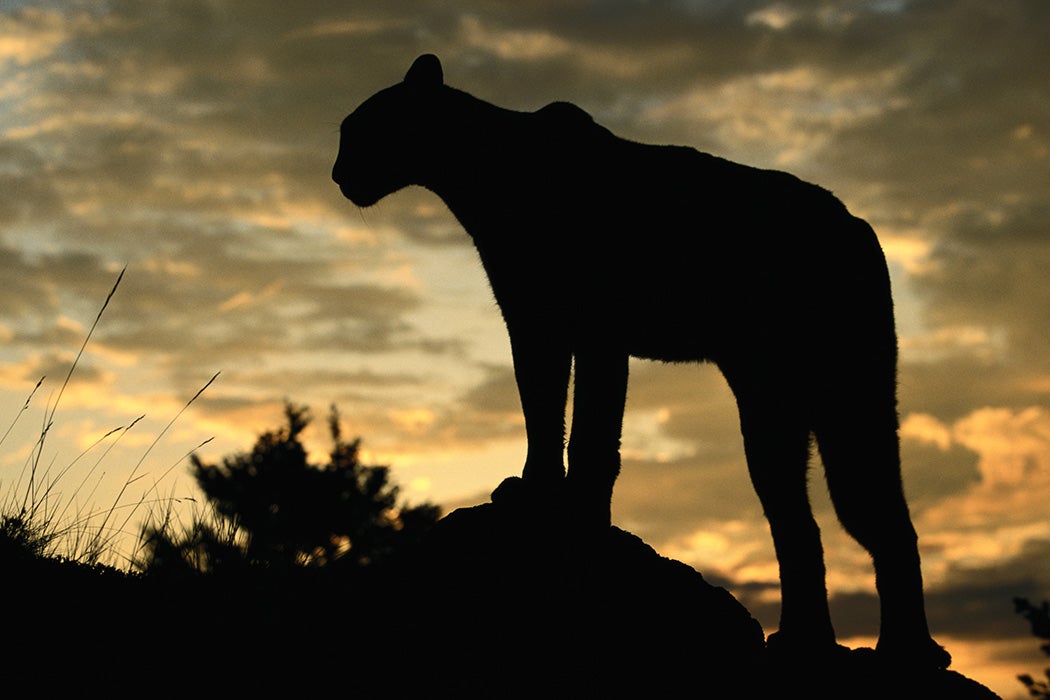Cougar, mountain lion, catamount, puma, panther… in North America, they’re all the same animal. Puma concolor, to give the beasts their scientific name, once called much of North and South America home. The last eastern North American cougar, however, was reported killed in 1938 on the Maine/Quebec border. Wildlife biologists James E. Cardoza and Susan A. Langlois give “human persecution, habitat loss and fragmentation, and depletion of white-tailed deer populations” as the reasons for their extirpation.
Deer, a big part of the cougar diet, have certainly come back, but the cats themselves are now extremely rare and newsworthy east of the Mississippi, north of Florida (where the small population of Florida panthers is listed as endangered), and south of Canada. Yet people claim to see them all the time in the eastern US. Thousands of sightings have been claimed since the 1950s. What’s going on?
“Credulity, lack of direction, and absence of scientific rigor contribute to the disarray and distrust that characterize cougar investigations in eastern North America,” write Cardoza and Langlois.
As with aliens and supernatural manifestations, some people want to believe that the truth is out there, walking on big cat feet. Such desire can play strange tricks on perception—while the rejection of that perception by officials and scientists can feed into conspiracy theories.
The need to see cougars may stem from the fact that they symbolize the wild like few other animals. Cougars can, after all, eat you, although that contingency is a remote one: in the last hundred years, there have been 126 documented cougar attacks on people in the US, 27 of them fatal. This compares to the 30–50 people killed every year in the US by pet dogs.
Believers ask why eyewitness evidence is accepted in courts, but not so much by science. Perhaps because science has repeatedly shown that eyewitnesses are notoriously unreliable—as too many overturned court verdicts have shown.
“Although some sightings may be valid,” write the authors, “we believe most are weak indicators of the animal’s presence. Misidentification, unconscious bias, poor memory, and observer veracity often taint eyewitness accounts.”
So what makes for good evidence? Bodies, pieces of body (most often hair,) and scat (feces). Such things are testable and verifiable. At least fifteen cougar corpses have been found in eastern North America, outside of Florida, since 1950.
“Most were known to be escapes of captive origin,” note the authors, because complicating matters is the fact that South American cougars end up in North America via the animal trade—it’s actually legal to own a cougar in many US states. Regarding dead cougars of unknown origin, they continue, “lone specimens are indicative of individuals, not populations, and do not answer the question of the cougar’s actual status.”
Weekly Newsletter
Since Cardoza and Langlois published, a 140-pound cougar was hit and killed by a car in Milford, on the coast of Connecticut, in June 2011. The cat wasn’t overweight, declawed, or microchipped—all evidence of “pet” status. In fact, the animal was genetically traced to the small population of cougars in the Black Hills of South Dakota. A young male, he had wandered 2000 miles east. He was, it developed, the same cat Wisconsin officials had been tracking in 2010—the genetic identification confirmed by hair and scat samples. This suggested a northern route through Canada and then down through upstate New York before the fateful car accident. (That’s two crossings of the international border—by swimming or passing by the unbelieving eyes of customs officials?)
So seeing a cougar in the east is not an impossibility. It may become more of a possibility as wandering individuals team up to repopulate territory rich again in deer. But phantom big cats continue to outnumber the flesh, blood, and porcupine quill-jabbed fur of real ones. Coyotes, domestic dogs, house cats, and fishers, among others, are still being misinterpreted—or upgraded—as the legendary catamount, the great cat of the mountain.







